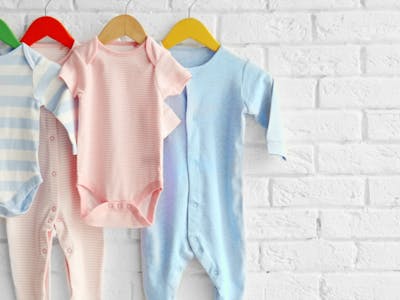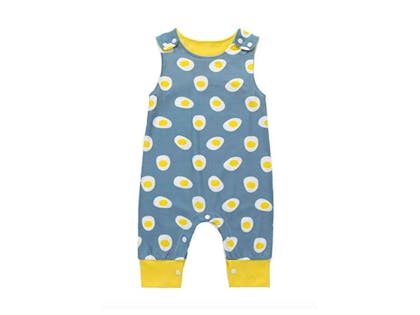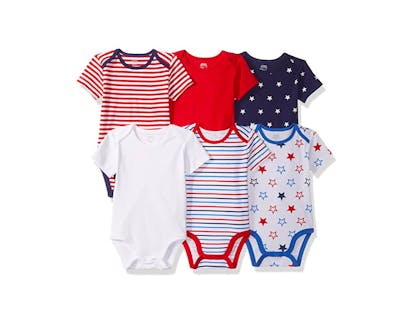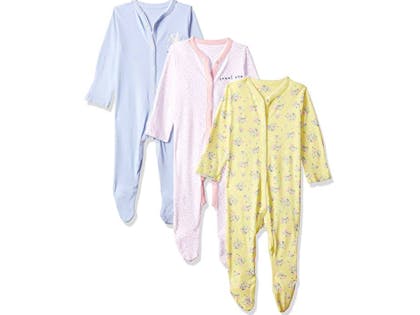buying guides
How to shop for baby clothes
This page contains affiliate links, which means we may earn a small amount of money if a reader clicks through and makes a purchase. All our articles and reviews are written independently by the Netmums editorial team.
Babies have a tendency to grow like weeds, doubling their birth weight in the first six months on average, and tripling it by a year, so you’re likely to need to replenish your stock of clothes and shoes for babies and toddlers on a regular basis.
Plus, of course, filling your baby’s wardrobe is one of the great pleasures of parenthood – who can resist those cute little outfits?
1. Printed dungaree-style romper
*Made from soft cotton blend material
*Designed with convenient popper openings
*Will fit babies from newborn to three years old
We LOVE these printed dungaree-style rompers that are available in a wide range of bold and bright prints and in a variety of sizes. They have handy popper openings at the shoulder and around the legs to make nappy changes much easier.
2. Bodysuits
*Feature envelope necklines
*Come in a handy set of six
*Sizes to fit from premature babies to two year olds
Buying bodysuits in bulk is a must - make sure you have at least six so there's always a clean one to pop on your baby. We love the striking designs of this six-pack of bodysuits that are available in sizes from newborn to around age two.
3. Sleepsuits
*Made from 100% cotton
*Machine-washable
*Come as a pack of three
Always go for multipacks when it comes to sleepsuits, as it makes them work out much cheaper than getting them singly. These sweet designs by Mothercare are such a good option for your little one. Made from 100% machine-washable cotton and convenient leg poppers, they're just what you need!
What to spend
This depends entirely on whether you’re shopping on a shoestring, working to an average budget or splashing the cash.
At the bottom end of the scale, clothing ranges from supermarkets and discount clothes stores are super-cheap, with basics starting from a couple of pounds.
If you’re going for designer labels, the sky's the limit, with a single luxury sleepsuit costing as much as £60.
Key features
When you’re shopping for baby clothes, it’s easy to get carried away, but think about what you actually need.
For example, you might want to splash out on an outfit for a special occasion, but if you’re shopping for nursery clothes, bear in mind that they’ll probably get filthy, so supermarket basics might do the trick.
If you’re buying tops, look for necklines that are easy to get over your baby’s head.
Envelope necklines and tops with poppers or buttons on one shoulder are great because you can stretch them wide as you pull them over his head.
Dungarees, romper suits and onesies are cute and comfortable for babies, but to make life easier, choose styles that have popper fastenings underneath the legs.
This will mean you don’t have to take the whole outfit off to change your baby’s nappy.
Try to find clothes with nickel-free poppers, as these are less likely to cause skin irritation.
When you’re choosing outfits for daytime, don’t forget to consider your baby’s comfort as well as the cute factor.
Ruffles, lace trim and fur-lined hoods may look adorable but could be irritating for your baby.
Likewise, bulky buttons or buckles on the back of outfits might prove uncomfortable when he’s lying down.
If your baby is mobile, think about how easily he’ll be able to move in the outfit – stiff denim jeans are likely to cramp his style more than soft joggers, while little girls can get their knees caught up in dresses and skirts when they’re crawling.
Sleepsuits are generally the most practical choice of outfit for newborns, and are lovely and comfortable for older babies to wear at night, too.
For small babies, integrated scratch mitts, where the cuffs of the sleeves fold over the hands, will help prevent them accidentally damaging themselves with their nails.
Once your baby is pulling up to standing and taking steps, look for sleep suits that are either footless or have non-slip soles so he doesn’t slide over.
Babies find it difficult to regulate their body temperature, so dressing your baby in layers is a wise move as you can add or remove items depending on how warm it is.
Bodysuits are a good base layer, and come in long-sleeve, short-sleeve and sleeveless styles.
Most fasten under the crotch with poppers, which stops the bodysuit coming untucked from your baby’s clothes; this will also make it harder for mischievous older babies to remove their nappy!
Soft cardigans are good on top of outfits for both sexes, and are easier to put on than jumpers.
Your baby will also need a coat – lightweight for spring and autumn, and thicker for winter – and a snowsuit for colder weather.
Don’t forget the accessories: sun hats are essential for sunny weather, and a warm winter hat for when it’s cold.
It’s sensible to have a few of these, as they’re all too easy to lose.
The same applies to socks, although you can buy special slip-on sock grippers that stop socks being pulled off.
The amount of baby clothes you need will depend on many factors, including your washing and drying facilities, the sort of activities your baby does, and whether he’s a sicky or dribbly baby.
Try to avoid going too mad, though: if you buy too much, some of it may hardly get worn before it’s outgrown.
And don’t forget to check washing instructions – clothes that can be thrown in the washing machine and tumble dried are infinitely more practical than those that need to be hand-washed!
Checklist
-
To help your baby regulate his body temperature, dress him in layers so you can add or take away a layer as required.
-
Tops with envelope, popper or button necklines are easiest to get on.
-
Look for dungarees, rompers and onesies with poppers between the legs for easy nappy changes.
- Avoid fussy details that might irritate your baby, particularly around the face
Read on:
- The best bath seats and supports for newborns
- Your must-have newborn changing kit
- Changing bag accessories you won’t be able to live without




 '
'
